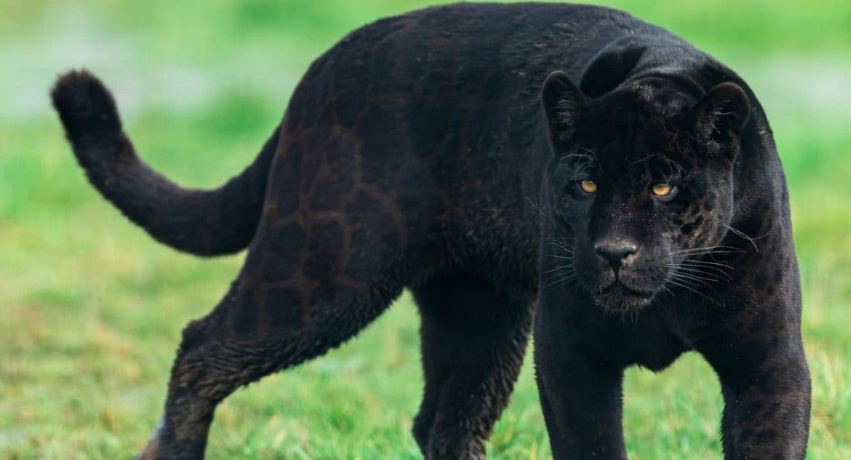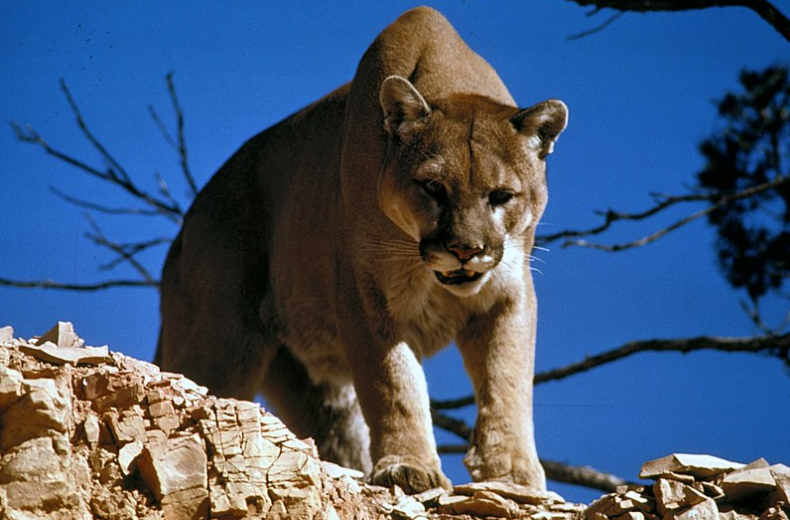Panther
The term “panther” is often used to refer to large, melanistic (black) individuals of big cat species, particularly the leopard and the jaguar. Black panthers of both species have excess black pigments, but their typical rosettes are also present. They have been documented mostly in tropical forests, with black leopards in Africa and Asia, and black jaguars in South America.
Black leopards are most commonly found in parts of Africa and some regions of Asia. What distinguishes these black leopards is their black coat, which conceals their rosette-shaped markings. In low light conditions or from a distance, these markings may still be faintly visible. Black leopards inhabit dense forests, grasslands and savannas.

Black jaguars, also referred to as black panthers in the Americas are primarily found in Central and South America. Like black leopards, black jaguars possess a dark black coat with rosette patterns that can be seen under specific lighting conditions. In general, Jaguars have a more extensive geographical range than leopards, they not only inhabit rainforests but also swamps, grasslands and other ecosystems. These large, solitary predators with ability to swim and are capable of hunting aquatic prey, such as caimans, crocodiles and fish.
Melanistic leopards and jaguars are uncommon, with some studies estimating that at most 11 percent of these animals have this coloration. Confirmed sightings, however, are less frequent, and confirmed sightings of black leopards, especially in Africa, are rare events. Before the most recent verified observation of a black leopard took place in Kenya in 2019, it had been 110 years since it had been photographed (and thus confirmed) in Africa.
Puma
The puma, scientifically known as Puma concolor, is a large and enigmatic big cat also known as the mountain lion, cougar, or catamount, depending on the region. This highly adaptable and solitary predator is native to the Americas, with a range extending from North America through Central America to the southernmost regions of South America.
Physically, the puma possesses a tan or grayish-brown coat, which lacks the rosette patterns seen in some other big cats like leopards and jaguars. The specific name concolor (“of one colour”) refers to the puma’s fur, which is uniformly brown on the back, sides, limbs, and tail. Puma have a sleek, well-muscled body, long legs, and a relatively small head with powerful jaws. Their most distinctive features is a long tail with a black tip, which sets them apart from other large cats in the Americas.

Pumas are the fourth-largest big cats globally, after tigers, lions, and jaguars. Their size can vary based on their geographic location and the availability of prey, but on average, they weigh between 29 to 72 kilograms (64 to 160 pounds) and can measure up to 2.7 meters (9 feet) from nose to tail. These large dimensions and physical prowess make them formidable predators.
Pumas are primarily solitary animals and have extensive home ranges, with males covering larger territories than females. Communication among pumas is through vocalizations, including whistles, screams and purring sounds. Mating can occur year-round but often peaks during late winter or early spring.
Their diet can include prey, such as deer, elk, smaller mammals, and occasionally livestock. Pumas are skilled stalk-and-ambush predators, relying on stealth and their powerful jaws to subdue prey.
In terms of conservation, pumas are considered a species of “Least Concern” by the International Union for Conservation of Nature (IUCN), which indicates that their populations are relatively stable.
Panther vs Puma: Key Differences
| Characteristic | Panther (Melanistic Leopard or Jaguar) | Puma (Mountain Lion or Cougar) |
|---|---|---|
| Scientific Name | Panthera pardus or Panthera onca, depending on species | Puma concolor |
| Geographic Range | Found primarily in Africa and parts of Asia | Native to the Americas, from North to South America |
| Coloration | Black coat with dark rosette patterns | Tan or grayish-brown, no spots |
| Spots or Markings | May have faint rosette-shaped markings | Generally no spots or markings |
| Tail | Long and slender with no black tip | Long and slender with a black tip |
| Body Size | Larger, typically 45-90 kg (100-200 lbs) | Smaller, typically 29-72 kg (64-160 lbs) |
| Vocalizations | Roaring, growling, and chuffing | Whistles, screams, purrs |
| Habitat | Diverse, including forests, savannas, and grasslands | Wide range, from mountains to deserts |
| Prey Preferences | Hunt a variety of animals, including large mammals | Primarily deer and smaller mammals |
| Range of Distribution | Depends on species, but often fragmented | North, Central, and South America |
| Conservation Status | Various species, some endangered | Generally stable or least concern |
| Social Behavior | Solitary and territorial | Solitary and territorial |
| Reproductive Habits | Mating can occur year-round | Mating primarily in late winter/early spring |
| Claw Usage | More reliance on claws for hunting | Relies more on jaw strength for killing prey |
| Can Climb Trees | Leopards can climb trees proficiently | Pumas are not as proficient climbers |
| Range of Sounds | Leopards and jaguars produce a wider range of vocalizations | Pumas have a more limited vocal range |